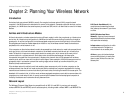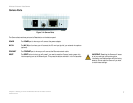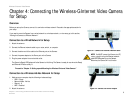
4
Chapter 2: Planning Your Wireless Network
Introduction
Wireless-G Internet Video Camera
Chapter 2: Planning Your Wireless Network
Introduction
A wireless local area network (WLAN) is exactly like a regular local area network (LAN), except that each
computer in the WLAN uses a wireless device to connect to the network. Computers and other devices, such as
peripherals, in a WLAN share the same frequency channel and SSID, which is an identification name for wireless
devices.
Ad-Hoc and Infrastructure Modes
Unlike wired networks, wireless networks have two different modes in which they may be set up: infrastructure
and ad-hoc. An infrastructure configuration is a WLAN and wired LAN communicating to each other through an
access point. An ad-hoc configuration is wireless-equipped computers communicating directly with each other.
Choosing between these two modes depends on whether or not the wireless network needs to share data or
peripherals with a wired network or not.
If the computers on the wireless network need to be accessed by a wired network or need to share a peripheral,
such as a printer, with the wired network computers, the wireless network should be set up in infrastructure
mode. The basis of infrastructure mode centers around an access point, which serves as the main point of
communications in a wireless network. (A wireless router can also be used because a wireless router
incorporates the capabilities of an access point.) Access points transmit data to PCs equipped with wireless
network cards, which can roam within a certain radial range of the access point. Multiple access points can be
arranged to work in succession to extend the roaming range, and can be set up to communicate with your
Ethernet (wired) hardware as well.
If the wireless network is relatively small and needs to share resources only with the other computers on the
wireless network, then the ad-hoc mode can be used. Ad-hoc mode allows computers equipped with wireless
transmitters and receivers to communicate directly with each other, eliminating the need for an access point. The
drawback of this mode is that, in Ad-Hoc mode, wireless-equipped computers are not able to communicate with
computers on a wired network. And, of course, communication between the wireless-equipped computers is
limited by the distance and interference directly between them.
Network Layout
The Wireless-G Internet Video Camera is compatible with all 802.11b and 802.11g routers, such as model
numbers BEFW11S4 and WRT54G, as well as access points, including model numbers WAP11 and WAP54G. The
Infrastructure: configuration in which
a wireless network is bridged to a
wired network via an access point.
LAN (Local Area Network): the
computers and networking products
that make up the network in your home
or office.
Ad-hoc: a group of wireless devices
communicating directly to each other
(peer-to-peer) without the use of an
access point.
WLAN (Wireless Local Area
Network): A group of computers and
associated devices that communicate
with each other wirelessly.


















